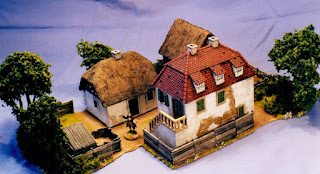Still at Hertford Uni in 2000, and having tried other kinds of model I wanted to be making historical ones. This was the time when Wargames Foundry had very ambitious plans, which I thought I might become part of. To test my work I was asked to make a wargames village and this was the result. As Foundry boss Bryan Ansell was still residing in Guernsey, I was asked to show it to his representative on earth, the sculptor Mark Copplestone. I remember spending a great afternoon with Mark in Birmingham, and seeing his sculpting, which I've always loved. He was impressed with my modelling work, and excited phone calls with Bryan ensued. Big plans were made. Foundry was all about big plans at that time.
The models found their way next to Kevin Dallimore (the famous painter of figures) who photographed them, and what you see below is part of the result. The figure of an eighteenth century artist was used by Kevin both to show scale and as a kind of trademark. The model was made to my "village unit" design, so comprised a base as well as three houses, a barn, a church a manor house, a pigsty and a muck-heap, all of which you can see here. Some of you may remember the wonderful modelling articles by "Stan Catchpol" (really Don or Bryan Fosten?) in Military Modelling magazine. One of them featured the modelling of straw and I always wanted to use the technique shown to construct a "smelly-looking" manure heap, so here it is!
The buildings and fences are authentically German-looking, but in a rather generic way. Later on I would get into researching vernacular architecture in more depth and discover that every area of Germany had its own local styles.
PS: Update: Going through my old folders I came across some more images of my Japanese castle model. As that was a popular post I have added three pictures to it now. It can be found as "My Earliest Model" under the Japan label in the blog's right-hand column.










Well by a fluke I saw your blog in the "blogs I follow" section of PWJ ONE MINUTE after you posted it -absolutely outstanding modelling skills once again. Reading between the lines of your comments about Foundry - were they planning to branch out into terrain and buildings, with you creating masters from which they could cast in resin? (Plans that obviously came to naught....)
ReplyDeleteWhat's PWJ, rross? And I think there was some talk of Foundry making terrain, but that was only a small part of the extravagant plans around, which all came to naught.
DeleteSorry - abbreviation for Palouse Wargaming Journal - the home of Mr J Freitag below
DeleteWonderful model buildings, John. The thought process and execution of your skill set is so clear and effective.
ReplyDeleteThis is an inspiring posting!
As said already these are exceptional models. You are most talented.
ReplyDeleteI particularly like the church and detachable cemetery you made for me.
Regards
John
Gorgeous works, John.
ReplyDeleteThanks once again for your comments, fellers. I hope by my posting things more or less chronologically you might be able to see the incremental improvement that came in over the years. Just as with painting wargames armies, part of the result comes from knowing the right materials, tools and techniques, which you can learn, or someone can show you. But the other part only comes from repeated practice.
ReplyDeleteKevin Dallimore expressed it well ( if a little harshly) when we were both doing work for Foundry: "People ask me how I do it, wanting to be told there's this secret, magic varnish which will make all your stuff look fantastic with no effort. What I want to tell them is that there's no such thing: just go away and paint a thousand figures, doing your best with each one. At the end of that I guarantee you'll be doing great painting!"
Great work, but I would like to see the bases without the buildings to get a better idea of how they might ben stored (the great wargaming unmentionable).
ReplyDeleteThat's a good point. We're not all Americans with the gigantic basements they seem to have! What I store them in is fruit boxes/ produce trays. Tesco used to leave them out for customers to take stuff away in. Maybe 4-6 village units will go in each and you make sure there are no trees to high to fit in a standard fruit box. These boxes are very strong and you can stack any number. Remember the buildings are freestanding, so if you have a church or other tall building that protrudes out of the top of the fruit box, you can gently lay it on its side. I keep all sorts of things in these fruit boxes: my trees, but also building materials like card, paper and sheet styrene. Conveniently the fruit trays also come in different depths, from about 3" to about 6".
Delete